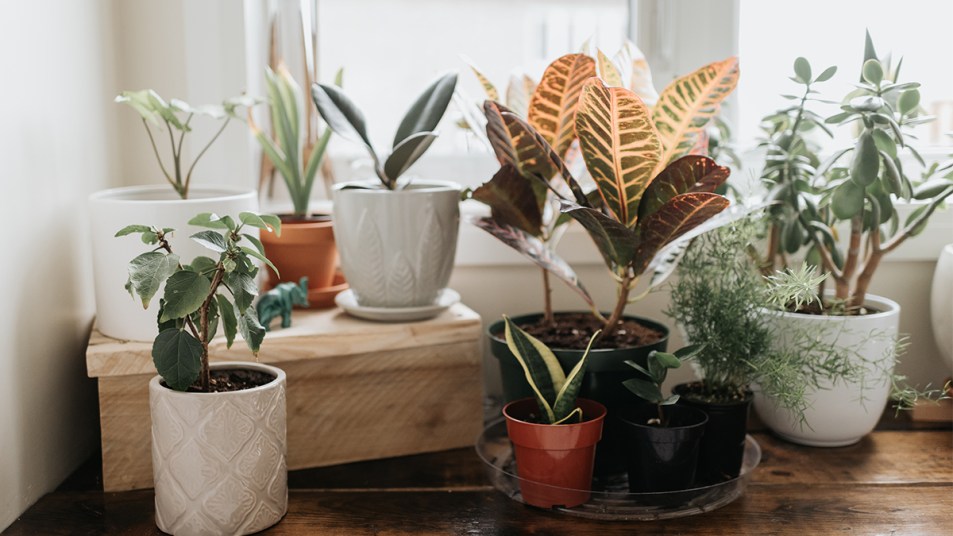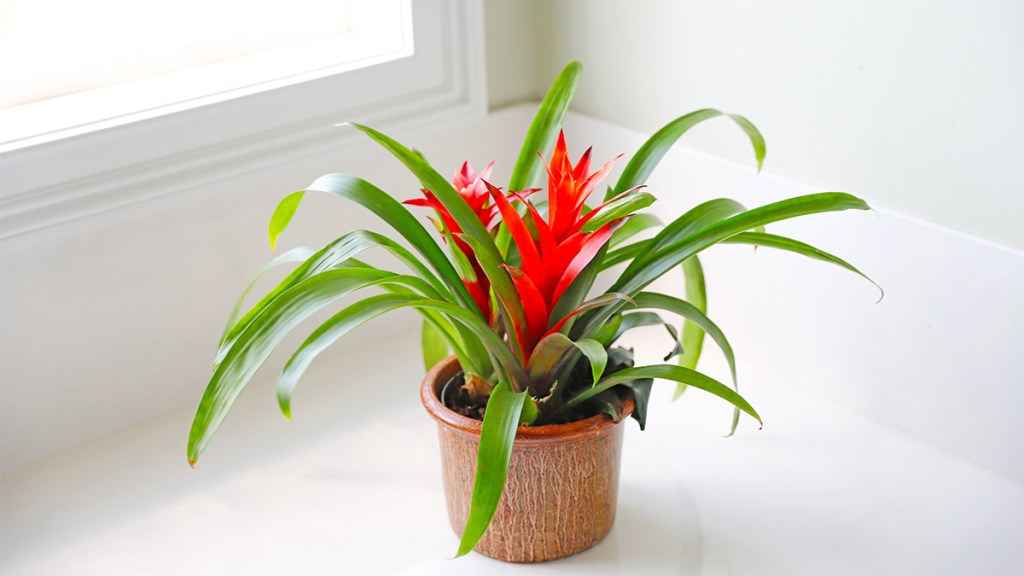Top MD: “The Air Inside Our Home Can Be 100x More Polluted Than Outdoor Air” — How to Outsmart Toxins to Feel Your Best
Discover the houseplant that reduces toxins by more than 80% — in hours!

The homes we live in are supposed to be safe havens. But a wealth of research reveals the poor quality of the air inside our homes can seriously sap our health — in fact, airborne toxins turned out to be the reason Michelle Allen suffered from debilitating headaches and fatigue for years. But then she learned how to improve indoor air quality, and her symptoms vanished. Read on for her story. But first, discover how you can clear the air and restore your energy too!
How indoor air pollutants undermine health
“The air inside our home can be 100 times more polluted than outdoor air,” says functional medicine expert Jill Carnahan, MD. And according to the Occupational Health and Safety Administration, exposure to indoor air pollutants has been linked to fatigue, concentration difficulties, headaches and eye, nose and throat irritation. Plus, researchers reporting in the North American Journal of Medical Science point out that indoor air pollution can increase the risk of cardiovascular disease.
The top culprits that sap indoor air quality
Before you can take action, you need to know what you’re dealing with! Keep scrolling for the top 3 culprits, then learn how to improve indoor air quality.
Volatile organic compounds (VOCs)
VOCs are a class of chemicals that can trigger tiredness, dizziness, breathing problems headaches and other draining symptoms. And formaldehyde is a VOC that’s particularly problematic. In fact, constant low-level exposure to formaldehyde has triggered an epidemic of sensitivities to other substances, says Leo Galland, MD, co-author of The Allergy Solution. “And this contributes in a major way to fatigue and weight gain.” Daily exposure, he says, creates inflammation that ups the chance the body will react to other chemicals and even foods. What’s more, formaldehyde can lurk in nearly every indoor space. The EPA notes it’s found in building materials, paints, glues, dishwashing liquids and more. But according to Dr. Galland, 9 in 10 women with aches, brain fog and stubborn pounds don’t know formaldehyde is to blame.
Mold and mycotoxins
Experts reporting in the Journal of Occupational and Environmental Hygiene found mold in 100% of U.S. homes they studied. Why that’s a problem: Findings from a Finnish study suggest exposure to mycotoxins produced by mold raises women’s risk of fatigue by 344%. Plus, authors determined that people exposed to mold in were nearly five times as likely to experience brain fog, and twice as likely to suffer from joint pain compared to their mold-free counterparts. “Mycotoxins trigger an inflammatory response that wreaks havoc on the immune system, nervous system and digestive system,” explains Taz Bhatia, MD, author of SuperWoman Rx. What’s more, a study in the journal Clinical and Translational Allergy reveals that mycotoxins can impair lung function to increase the odds of asthma and other breathing problems by 243%.
Chemical cocktails in household dust
It’s no secret the soil we bring into our homes on our shoes creates dust. But a report in the journal Environmental Science &Technology reveals that dust can harbor herbicides linked to weakness and fatigue. Separate findings in the same journal found 10 toxic chemicals – including phthalates – in more than 90% of household dust samples. That’s cause for concern, since a study in the journal Environmental Health Perspectives suggests exposure to phthalates can lower levels of energizing thyroid hormones.
Is indoor air pollution making you tired?

HVAC companies can test your air quality. And while there’s no medical test for formaldehyde-induce sensitivities, doctors can conduct blood and urine tests to detect problem-causers such as phthalates and mycotoxins. Symptoms can also serve as red flags of poor indoor air quality. So, if you experience the following, toxins in your home may be to blame.
- Fatigue
- Brain fog
- Headaches
- Dizziness
- Eye, nose or throat irritation
- Congestion
- Asthma attacks
- Nausea
- Cough
How to improve indoor air quality
An Indoor Environmental Professional (IEP) can implement strategies that help clear contaminants from indoor air (to find one closest to you, check the listing available at the International Society of Acquired Environmental Illness). But since Dr. Carnahan says all homes harbor indoor pollutants, consider the steps below to reduce your risk and restore your energy.
Keep ducts and filters clean

Mold that originates in the coils and drains of your home’s HVAC system can spread through ductwork, spiling spores into rooms. To prevent that, Bill Rawls, MD advises having systems serviced annually. And while fitting your HVAC system with a HEPA filter removes up to 99.97% of airborne particles like mold and dust, Dr. Carnahan also recommends replacing your furnace filter with one that has a high Minimum Efficiency Reporting Value (MERV). “Filters higher on the MERV scale remove finer particles,” explains Dr. Carnahan. “When it comes to tiny mold spores, you want to aim for a MERV rating of 8 or higher.” To outsmart other mold hotspots, Dr. Taz advises cleaning shower heads, stalls and tubs with white vinegar. According to experts at Mississippi State University, white vinegar kills 82% of mold.
Open a window
Joseph Mercola, DO, author of Effortless Healing, says kitchens and bathrooms can harbor higher VOC levels, thanks to frequent use of harsh cleaning products. The fix? Switch on an exhaust fan in these rooms. Also smart: Open windows in your home whenever possible. A study in the journal Procedia Engineering found that doing so lowered formaldehyde levels in indoor air by 91% within one hour.
Decorate with houseplants

“Houseplants combat brain fog and body bog by removing pollutants from the air,” says Sara Szal Gottfried, MD. To get the benefits, she advises placing proven air-clearers like bromeliad, dracaena and jade plants) in the rooms where you spend the most time. Research published in the journal Royal Society of Chemistry Advances shows the houseplants have a powerful ability to lower levels of VOCs. In fact, bromeliad slashed levels of six VOCs by more than 80% within 12 hours.
Toss wipes outside
We rely on disinfectant cleaners to kills germs. But according to experts at University of California, the VOCs they contain can waft from rags and paper towels tossed in kitchen and bathroom wastebaskets, more than doubling the level of toxic glycol ethers in the air. Easy ways to slash exposure: Wash rags right after usinga, and tote used paper towels and wipes to an outdoor trash bin.
Trap dirt at the door

Place carpets or mats in entryways and kick off your shoes when you step inside. In the same study that detected herbicides in dust, the strategies cut household levels of the chemicals by up to 46%. And in a toxin-taming bonus, findings in the journal Science in the Total Environment reveal leaving shoes at the door substantially lowers indoor concentrations of heavy metals found in soil, including nickel, cadmium and lead.
Indoor toxins success story: Michelle Allen, 44

44-year-old Michelle Allen had been struggling with fatigue, migraines, and allergies for five years. She assumed her work as a real estate agent was the main culprit, draining her energy and causing stress. Yet that reasoning didn’t explain why she had to skip out on family plans every weekend and take naps every afternoon.
“Like clockwork, every day at 2 p.m., I felt a powerful need to nap,” she tells FIRST. “I’d either find a way to stop at home or simply close the blinds and doze in my office … Pain was also a set part of my schedule. I started keeping my migraine medicine on top of my desk, like my stapler, since I needed it so often. I even referred to it as candy. I’d be talking to my husband on the phone and feel a headache coming on and say, ‘I’ve got to go. It’s time for my M&M’s.’ That sounds terrible, but that was my routine.”
A problem at home
Strangely enough, Allen wasn’t the only person in her house with symptoms. “My husband and two sons were constantly dealing with stuffy noses and sinus drainage,” she explains. “But I figured we were in the germ-y school years. I can’t even tally how many $40 boxes of allergy meds we bought.”
Allen admits that she did not seek professional help for her symptoms. “I never talked to my doctor about my fatigue and headaches,” she says. “They simply became part of my lifestyle. I sort of forgot where I ended and my symptoms began. Plus, I’d already had a lifetime’s worth of doctor visits. As a breast cancer survivor, I was happy to be alive. Still, I wished I wasn’t missing so many memory-making opportunities with my family.”
So, what was causing Allen to feel under-the-weather 24/7? She didn’t find out until she got her home air quality inspected. “One day, it was time for our home’s HVAC system to be inspected,” she continues. “Jason, the technician from Aire Serv, a Neighborly company, came out of the attic and asked, ‘Do y’all have allergies?’”
Jason wasn’t surprised; he had found a lot of dust in the attic. He used a machine to test the quality of Allen’s indoor air, and made additional discoveries: Allen’s home had high levels of pollen, pet dander (from Allen’s two dogs), and other pollutants. Even worse, the machine showed that the family was breathing dangerous volatile organic compounds, or VOCs.
“I’d heard that term back when I was pregnant — with warnings not to be around paint fumes in the nursery — but since then, I had never thought about the harmful compounds surrounding me at home and in the houses I tour for my job,” Allen says.
How Michelle improved her home’s indoor air quality
“Since it was time to update my HVAC system anyway, I replaced the unit,” Allen says. “I even had a special UV-oxidizing light bulb installed with it inside my ducting to kill airborne microbes and neutralize off-gases. In the vent grates, I placed special filters (mine cost $120 for the year) that magnetize dust particles so they form clumps large enough to be captured. I couldn’t believe how much gunk they kept from recirculating. I also switched to natural cleaning products to purify the air in my home. And I started vacuuming more often — simple tweaks that didn’t cost much but helped me feel better right away.
“Within a month, I realized I had the energy to do things like attend my kids’ ballgames. I no longer longed for rest. I was sleeping better at night and not having headaches. Amazingly, we didn’t need to buy allergy medicine the entire year, even during peak sneezing season!
“I figured the new HVAC system would pay for itself in five years just from saving money on allergy medicine. But considering the increased productivity I was seeing in my career and how I was able to fully participate in my family’s life, it has already paid for itself!
“The long-term health benefits are a huge bonus for me. I love knowing I’m avoiding future illnesses and doctor visits. Now I tell everyone to test their indoor air. A home should be a safe haven, not someplace that makes you sick. I’m so happy to have my health back.”
This content is not a substitute for professional medical advice or diagnosis. Always consult your physician before pursuing any treatment plan.
For more on indoor air quality, keep reading!
How To Get Rid of Musty Basement Smells + Why You May Want To Act Fast
8 Ways to Improve the Air Quality and Remove Toxins in Your Home
The Reason You Can’t Get Rid of ‘Pink Mold’ Is That It’s Actually a Bacterium — Here’s How To Wipe It Out For Good

















